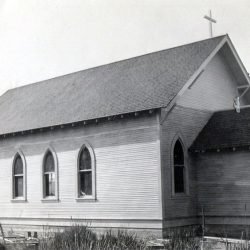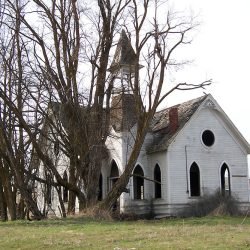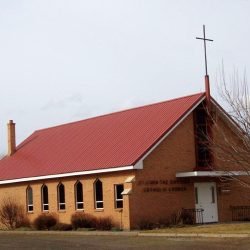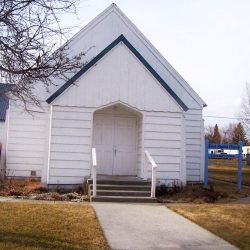Pioneer settlers reported rye grass so tall in this region that it was well over a man’s head, even so when on horseback. The Cutoff to the Barlow Road runs right through Grass Valley. The first white settlers were Californians, Dr. C.R. Rollins and his son, John W. Dow and his wife, Mr. Locke and Frank Richie in 1878. Dr. Rollins claimed to have grown and threshed the first wheat in 1879. He built a hotel, platted and named the town, established an inn, Grass Valley House, and was the only practicing physician between the rivers and south to Antelope. The Grass Valley Journal was started in November 1897 by stockholders C.E. Brown, G.W. Bourhill, J.H. Smith, William Holder, C.W. Moore and J.D. Wilcox. W.I. Westerfield purchased the paper in 1900.
The 1898 business directory lists: Moore & Rollins, Scott & Co. general merchandise; R. Smith, Mrs. G.C. Vintin, hotel keepers; John Dam, Frank Lynn, blacksmiths; George Clements, John Trainer, boot, shoe and repair shops; Bourhill & Co., hardware, wagons and machinery; Dr. Snooks, druggist and physician; Miss Minnie Smith, confectionery; William Fairfield, steam chop mill; J.H. Berger, furniture; G.C. Vintin, R. Smith, livery stable; Mrs. Gleeson, dressmaker; O.P. King, meat market; Clark E. Brown, Grass Valley Journal.
The first white settlers were Californians, Dr. C.R. Rollins and his son, John W. Dow and his wife, Mr. Locke and Frank Richie in 1878. Dr. Rollins claimed to have grown and threshed the first wheat in 1879. He built a hotel, platted and named the town, established an inn, Grass Valley House, and was the only practicing physician between the rivers and south to Antelope.
The town had a Baptist Church, AOUW Lodge #65, Grass Valley IOOF Lodge #131, IORM Modoc Camp #39, PHS Good Samaritan Circle #325, undertaker, carpenter-contractor, justice of the peace, insurance agent, miller, minister, stone mason, attorney, teachers, painter, stock inspector, shoemaker and the Middle Oregon Baptist Academy. Outlying farmers, cattlemen and sheep raisers supported the town.
Families in the precinct were Allen, Allison, Bailey, Atkins, Bain, Barnett, Bates, Batman, Bennett, Berger, Booten, Bourhill, Brown, Brownhill, Buckley, Burns, Campbell, Case, Cavadini, Clements, Clark, Cleveland, Coon, Coyle, Cramer, Curl, Cushman, Daugherty, Davenport, Davis, Denis, Detjen, Dugger, Dunn, Dupuy, Dyce, Evans, Fairchild, Fairfield, Foster, Fredenburg, French, Frock, Gilham, Gilman, Gibson, Grosser, Grouse, Hargreaves, Haug, Hawley, Hays, Heath, Hembree, Henton, Herren, Hillgen, Hill, Hogan, Holder, Holmes, Houghton, Huff, Iams, James, Jennings, Jewell, Jones, Keast, Kelsay, Kerr, King, Kohansky, Knudsen, Krusow, Lemon, Lewis, Link, Logan, Lyons, McLeod, Mahany, Marquis, Marshall, Mills, Mitchell, Moore, Morrissey, Munger, Nachand, Neece, Nelson, Newcomb, Noguier, Noble, Offield, O’Leary, Olds, Patterson, Perrault, Peters, Rawlins, Reckmann, Rollins, Schwartz, Scott, Smith, Snook, Spencer, Sproul, Stanton, Tegethoff, Thompson, Tilson, Titus, Turner, Van Winkle, Vinton, Willett and Willis.
Charles Taylor started the post office in 1882 or 1885 at his residence along the stage route, later the Olds place and later the Alfred Kock place. Emmett Olds became postmaster in 1887. John Fulton surveyed the town site in April 1889. C.E. Brown was the postmaster in 1898 with Mrs. C.E. Brown as assistant, and mail was delivered daily by stage via Wasco and Moro. ~Carsten von Borstel; Wasco and Sherman County Directory 1898.
The three great essentials to achieve anything worth while are: Hard work, Stick-to-itiveness, and Common sense. – Thomas A. Edison














